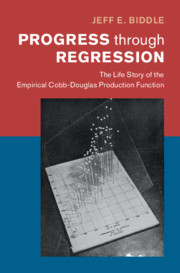Book contents
- Progress through Regression
- Historical Perspectives On Modern Economics
- Progress through Regression
- Copyright page
- Dedication
- Contents
- Figures
- Acknowledgments
- Introduction
- Part I Paul Douglas and His Regression, 1927–1948
- Part II The Diffusion of the Cobb–Douglas Regression
- Part III Conclusion
- References
- Index
- Historical Perspectives On Modern Economics
Introduction
Published online by Cambridge University Press: 30 October 2020
- Progress through Regression
- Historical Perspectives On Modern Economics
- Progress through Regression
- Copyright page
- Dedication
- Contents
- Figures
- Acknowledgments
- Introduction
- Part I Paul Douglas and His Regression, 1927–1948
- Part II The Diffusion of the Cobb–Douglas Regression
- Part III Conclusion
- References
- Index
- Historical Perspectives On Modern Economics
Summary
The introduction provides an overview of the book. Although Paul Douglas is the most important person in the story of the Cobb–Douglas regression, the book is not a biography of Douglas, but of his best known and most successful creation. The book covers the period from the mid-1920s, when Douglas was doing the statistical work that led to the first use of the Cobb–Douglas regression, to the late 1960s, when Douglas’s idea had come to be widely accepted by economists, and the CES production function was emerging as the first popular alternative to the Cobb–Douglas function for estimation of production functions. My perspective is mainly that of a historian of the use of statistical analysis in economics, with particular attention given to the challenges faced by empirical researchers, and the roles played by statistical and economic theory in their development of strategies to overcome them. At various point in the book, I reflect on factors that might have helped the production function regression go from an innovative and controversial statistical procedure to a widely accepted general purpose tool in empirical economics.
Information
- Type
- Chapter
- Information
- Progress through RegressionThe Life Story of the Empirical Cobb-Douglas Production Function, pp. 1 - 10Publisher: Cambridge University PressPrint publication year: 2020
